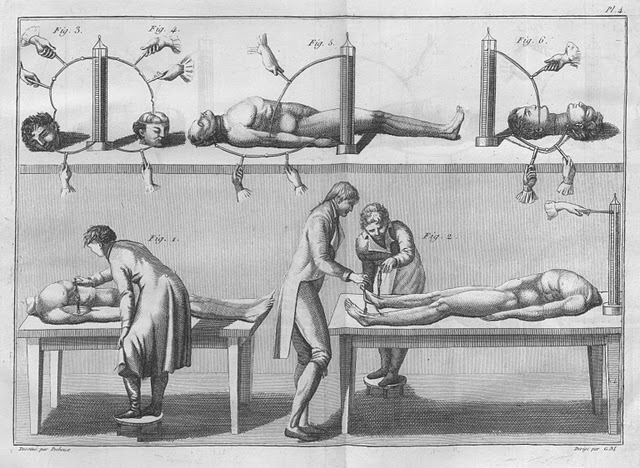 |
| Main Menu - click above |
Galvanic Reanimation of the Dead
The exploits of nineteenth century scientists with electrical batteries and corpses.
The Galvanic Reanimation of Matthew Clydesdale
Experiments were performed on the corpse of Matthew Clydesdale (a freshly killed murderer) at the Glasgow University anatomy theatre, by Dr. Ure and Prof. Jeffray on the 4th november 1818
This account, from The Young Man`s Book of Amusement.
Giovanni Aldini
Aldini's experiments with butchered murderers
A very ample series of experiments were made by Professor Aldini which show the eminent and superior power of galvanism beyond any other stimulant in nature. In the months of January and February last, he had the courage to apply it at Bologna to the bodies of various criminals who had suffered death at that place, and by means of the pile he excited the remaining vital forces in a most astonishing manner.
This stimulus produced the most horrible contortions and grimaces by the motions of the muscles of the head and face; and an hour and a quarter after death, the arm of one of the bodies was elevated eight inches from the table on which it was supported, and this even when a considerable weight was placed in the hand.
This stimulus produced the most horrible contortions and grimaces by the motions of the muscles of the head and face; and an hour and a quarter after death, the arm of one of the bodies was elevated eight inches from the table on which it was supported, and this even when a considerable weight was placed in the hand.
On the first application of the process to the face, the jaws of the deceased criminal began to quiver, and the adjoining muscles were horribly contorted, and one eye was actually opened. In the subsequent part of the process the right hand was raised and clenched, and the legs and thighs were set in motion. Mr Pass, the beadle of the Surgeons’ Company, who was officially present during this experiment, was so alarmed that he died of fright soon after his return home.
“the jaw began to quiver, the adjoining muscles were horribly contorted, and the left eye actually opened … The action even of those muscles furthest distant from the points of contact with the arc was so much increased as almost to give an appearance of re-animation … vitality might, perhaps, have been restored, if many circumstances had not rendered it impossible.”
"Galvanism was communicated by means of three troughs combined together, each of which contained forty plates of zinc, and as many of copper. On the first application of the arcs the jaw began to quiver, the adjoining muscles were horribly contorted, and the left eye actually opened."
"The first of these decapitated criminals being conveyed to the apartment provided for my experiments, in the neighbourhood of the place of execution, the head was first subjected to the Galvanic action. For this purpose I had constructed a pile consisting of a hundred pieces of silver and zinc. Having moistened the inside of the ears with salt water, I formed an arc with two metallic wires, which, proceeding from the two ears, were applied, one to the summit and the other to the bottom of the pile. When this communication was established, I observed strong contractions in the muscles of the face, which were contorted in so irregular a manner that they exhibited the appearance of the most horrid grimaces. The action of the eye-lids was exceedingly striking, though less sensible in the human head than in that of an ox."
The reanimation of the dead was a subject of interest for Ernest Glitch, the eccentric Victorian experimentalist. |
"As you can see, the positive prime conductor is connected to the common lower plate. I use a copper wire conductor (from my galvanic experiments on the dead body of a criminal) to communicate the upper plates." from Victorian Nitrogen Laser
"Glitch dragged his eyes from the dead face and consulted his timepiece, "My goodness! We have only a minute to effect re-animation! Ted, remember well that quotation from Leonardo Da Vinci, it is a philosophy I continually try to instill into my assistant. Hodges! The digitalis, coramine and strychnine syringe with, I think, a five inch needle. Look smart man! These men are dead!" from The Glitch Ranunculaceous Death-Spray
The secret of imbuing inanimate bodies with life is, of course, the story of Frankenstein |
"How I, then a young girl, came to think of, and to dilate upon, so very hideous an idea?"
asks Mary Shelley, who conceived the idea for her novel during the "Year Without a Summer," following the eruption of Tambora.
Frankenstein: or, The modern Prometheus
By Mary Wollstonecraft Shelley
scroll down using controls at right
By Mary Wollstonecraft Shelley
scroll down using controls at right
Another reanimation theme is presented in the following grippingly dull short story, published in 1863
Sentenced to Death. A True Story. By Wilmot Buxton
scroll down using controls at right, use + button to magnify
"Le docteur Ure galvanisant le corps de l'assassin Clydsdale."
Note the electric battery to the far left of Clydesdale's head and the drunk who is unaware of the dead man's grimaces
An engraving from Les merveilles de la Science (1867) by Louis Figuier
 |
| Please help beat cancer - DONATE click above |
Unrelated to this post, below is an example of
eclectic science esoterica
Anode electrolytic heating (AEH) of steel stick in ammonium chloride solution


 |
| Main Menu - click above |











.jpg)

.jpg/477px-Frankenstein's_monster_(Boris_Karloff).jpg)

